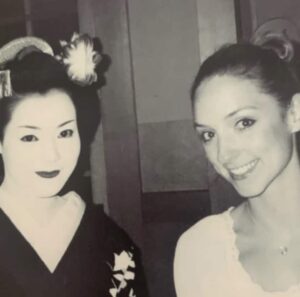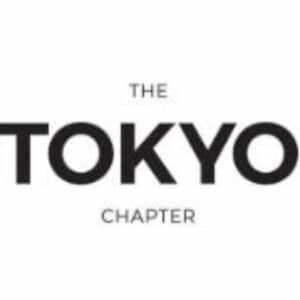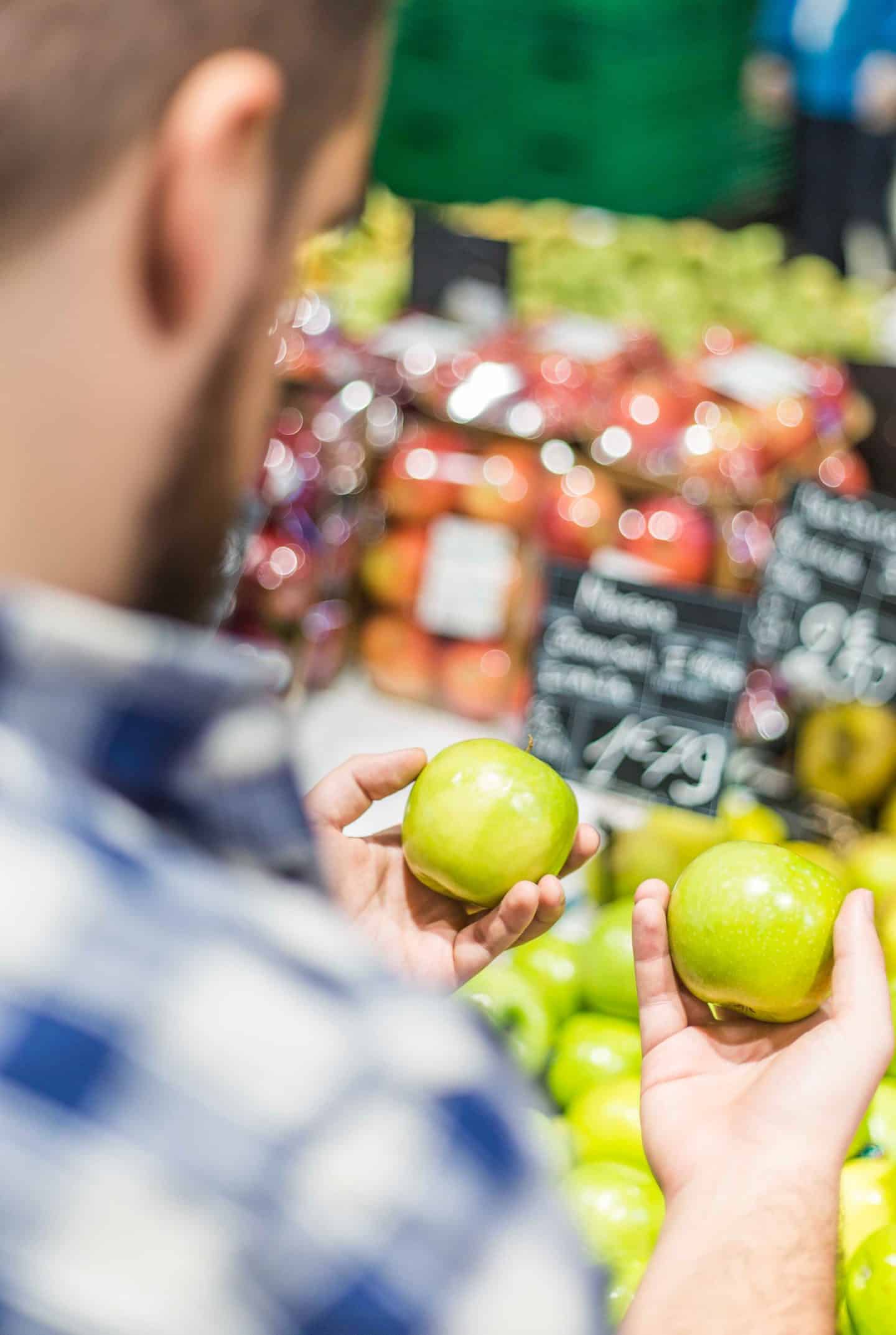
7 SURPRISES WHEN YOU VISIT A JAPANESE SUPERMARKET
I’m a huge Will & Grace fan and I always think of that tongue in cheek quote :
“Well, yeah. Why else go to foreign countries? You can watch MTV in funny languages and see what their Coke tastes like.”
But I’d add to the list ‘…and see what their supermarkets look like…’
SO MANY PEOPLE GET HUNG UP ON CONVENIENCE STORES IN JAPAN – SO MUCH SO THAT THEY FORGET ABOUT SUPERMARKETS!
JAPANESE SUPERMARKETS HAVE EVEN MORE AMAZING PRECOOKED OPTIONS AND MORE VEGETARIAN, GLUTEN FREE, SOY OPTIONS TOO.
If you do, however, want to know more about Japanese convenience store recommedations – click here.
I LOVE going to supermarkets in different countries.
I want to know what they have, what are the options and what do I want to take home!
There are some things that you might be surprised about when first shopping in a Japanese supermarket and I thought I’d share.
1.Everything is smaller
This is a non-brainer (especially in Tokyo) when it comes to the actual building size and the aisle size.
The baskets and carts are also smaller.
But also when it comes to the products. Have you seen a loaf of bread in Japan? It’s sold at a half-size too ( and you can choose how many slices you get in that half loaf too – we always get the 8 slices.)
This makes more sense the longer that you’ve lived in Japan and realize that you need smaller options to lug home on foot or in a bike as having a car isn’t that common.
2. Everyone goes to the supermarket a LOT more often
It is common for people to buy fresh ingredients everyday.
Once again, this also makes a lot more sense once you’ve lived in Tokyo for a while. The cupboard and fridge space is limited in little houses – and Japanese people just value fresh ingredients and the convenience of daily stocked supermarkets, convenience stores and bakeries over buying in bulk.
We don’t necessarily join in on this idea in my household. However, I have got used to that idea of a convenience store or vending machine just outside my door and I think of it in the same way many people overseas think of that extra freezer in their garage… it’s my back up ‘stash.’
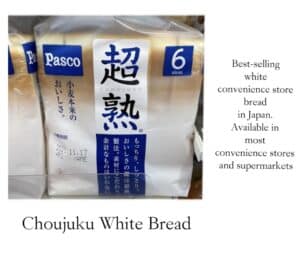
3.There are less options for ingredients but way more for ready-made meals.
This is something that I get excited about when I’m outside of Japan.
It’s funny (and, lets face it, a bit frustrating) that I can buy a notebook or a pen in any colour of the rainbow in Japan BUT there is only one or two brands of pasta sauce to choose from.
For this reason, I often get a bit loyal to certain places and my shopping list might sometimes be separated into ‘Amazon’, ‘ Supermarket A’ ‘Supermarket B’ ‘International Supermarket’ ‘Convenience Store’, ‘Fruit n Veg’ shop etc… It was annoying at first but once we found our groove, I just got better at remembering which shop to stop at when I was in the area.
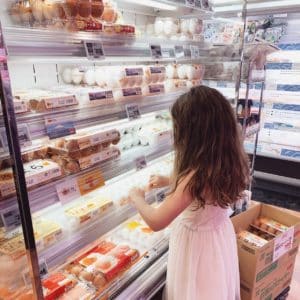
The ready made meal options and bentos are incredible! If you think the convenience store meals are amazing – wait until you see the choices at the supermarkets!
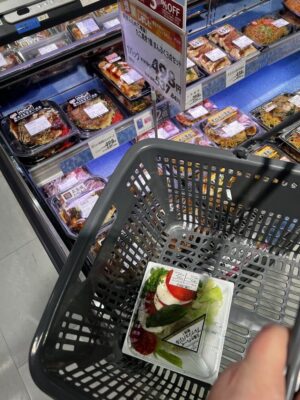
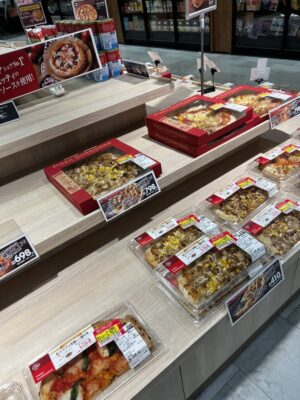
4.You’ll start to realize that countries are weird about diet food options
I feel like it’s interesting to go outside of Japan and look at ….let’s say the hot chocolate options in Australian supermarkets. There is a fat -free, gluten free, sugar free, powdered down, ready-made ….all the options under the sun. Japan DEFINITELY still has PLENTY of processed food but there is also a LOT more real food. So, although there are less options, I feel like there are more real options.
5. Cheese & Fruit is expensive*
I recommend shopping around at a few different supermarkets in Tokyo to find your best options. Also, if you’re out of the city for sightseeing or running errands, you’ll often find that the suburban options are cheaper too.
Keep an eye out for Farmer’s Markets for cheaper, organic options.
You might also like to take a look at Hanamasa Wholesale Supermarkets for these items too.
Also, for fruit’n’veg, I find that the local fruit and vegetable shops are MUCH cheaper (and they will deliver if you purchase over a certain amount.) The often only accept cash.
Also, as a general rule, try your best to buy the vegetables that are in season – it will save you so much money.
*I must say though, I think Japanese fruit is some of the most delicious fruit I have ever eaten in my life.
I wrote more about shopping for reasonably priced fruit in Japan here.
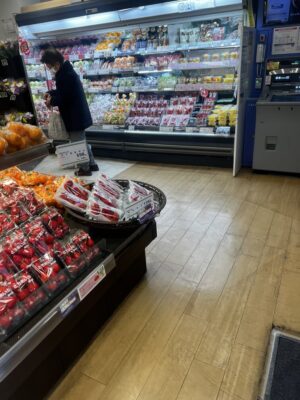
6.Most supermarkets have a deli section and or bakery
Some are better than others but there are almost always decent options to help with a lazy throw together dinner or a bento box for right after shopping.
When tired, these sections help me buy a little something like a crumbed chicken cutlet or gyoza or gratin to pair with a salad.
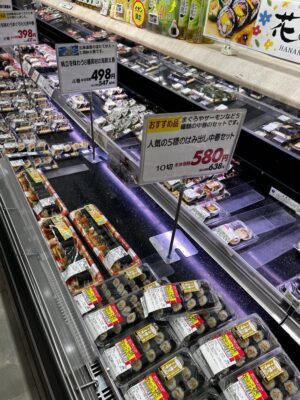
7.Your supermarket will deliver
Every supermarket will have different rules. Some will need you to spend a certain amount. Some will, naturally, need you live in a certain area.
A few will deliver everything and others will take everything except for eggs or frozen foods.
* Japan still has a long way to go when it comes to internet shopping too. However, Amazon Japan saves my life a few times a week (how did I ever survive without it? )
So I go to the supermarket, fill my trolley, pay and my groceries meet me at home the same day.
My fruit’n’veg man sometimes beats me up the hill!
This is how the locals mostly do a big shop for their family. (You do need to confirm that you are in the store’s delivery zone – of course. ) Note that same day delivery cut-offs are often around 2pm.
In my experience, most supermarkets deliver for purchases over 5000 yen (Maruetsu delivers for free for only 1800 yen +)
Feel free to point at these sentences too, if you need.
当日配達は可能ですか? Is same-day delivery possible?
配達料金はいくらですか? How much does delivery cost?
8. In rural areas, baby food and snacks aren’t always found in supermarkets
You will have more luck in a drugstore, a baby goods store like Akachan Hompo, or even some stores like Yodobashi Camera or BIC Camera.
Extra tip: If you’re looking for cauliflower “rice” or broccoli “rice” go to the freezer sections of Aeon or My Basket supermarkets.
9. Most supermarkets require you to pack your own groceries after paying
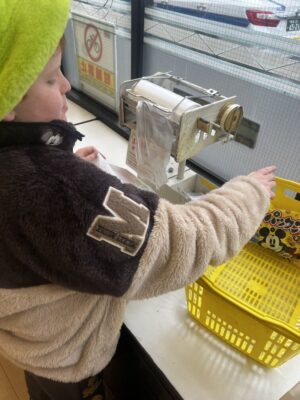
If you would like to have vegan products including different types of milk delivered anywhere in Japan, I recommend going to the National Azabu website. This international supermarket is located in Hiroo, Tokyo (you can also, of course, visit in person). You can also order online and have them deliver groceries to you if you are staying in Minato-ku, Tokyo (aka the Minato ward, Tokyo) OR you can have these items delivered anywhere in Japan using the Yamato delivery service (price is from 1200 yen per box of food delivered.) This is one of many reasons to stay at a hotel and not an airbnb in Japan – so that a hotel can accept parcels on your behalf -if you’re super clever, you can order ahead and have a box of low-allergen foods for you arrive the day you check in to your hotel (if you email the hotel ahead – they will put cold items in the fridge for you.) National Azabu in Tokyo stocks almond milk, oat milk, walnut milk, soy milk as well as pistachio milk. Here is my general advice on buying different types of milk in Japan.
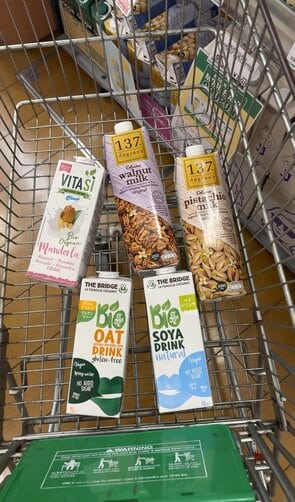
MY FAVOURITE TOKYO SUPERMARKETS
Life
Peacock
Hanamasa (for cheese and some meat)
Meidiya (mainly because I love their deli and bakery sections too)
National Azabu, International Supermarket ( I love their falafel and cheese selection. They also have real Cheetos & dairy milk chocolate.)
Nissen ( my family love their wagyu hamburger patties and they also have a great wine selection
Lincos
Bio C Bon
Maruetsu & Maruetsu Petit
Aeon (which also owns a supermarket chain called ” My Basket”
If you found this article helpful I think you’ll also enjoy my post called “Department Stores: 5 things the cashier is asking you“
Examples of what you will find in Japanese Supermarkets
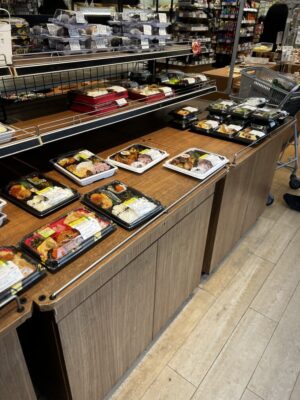
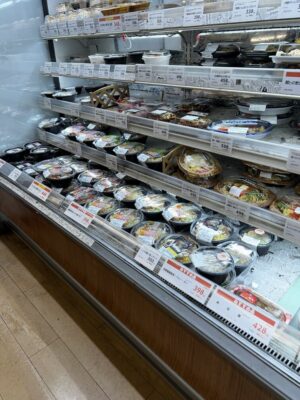
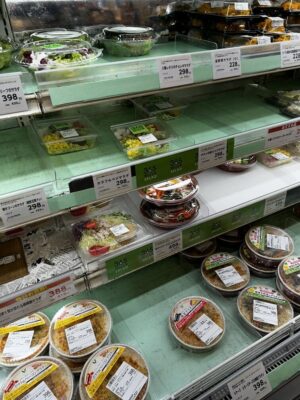
Top shelf here has 3 types of lettuce choregi salad & steamed veg salad.
Second shelf has cooked corn salad, colourful veggie salad, a chicken cob salad, 3 types of lettuce caesar salad.
Vegie meat & Korean Namul Salad, Egg & Macaroni Salad.
Bottom Shelf:
Potato & Bacon Gratin, Cheese and Shrimp Gratin, 4 types of veg Gratin.
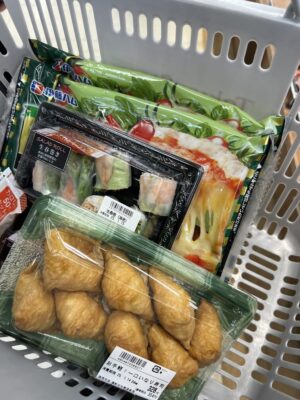
In my basket I have bite-sized inari, paper spring rolls with salad and shrimp & a satchet of sweet chilli, 2 x premade margherita pizzas (these are from the fridge not freezer section.)
Some of my kids’ favourite supermarket snacks
My little boy, in particular, adores these little savoury goldfish crackers , Ottotto ( a much lighter and less flavoured and more savoury tasting goldfish than the U.S. option.)
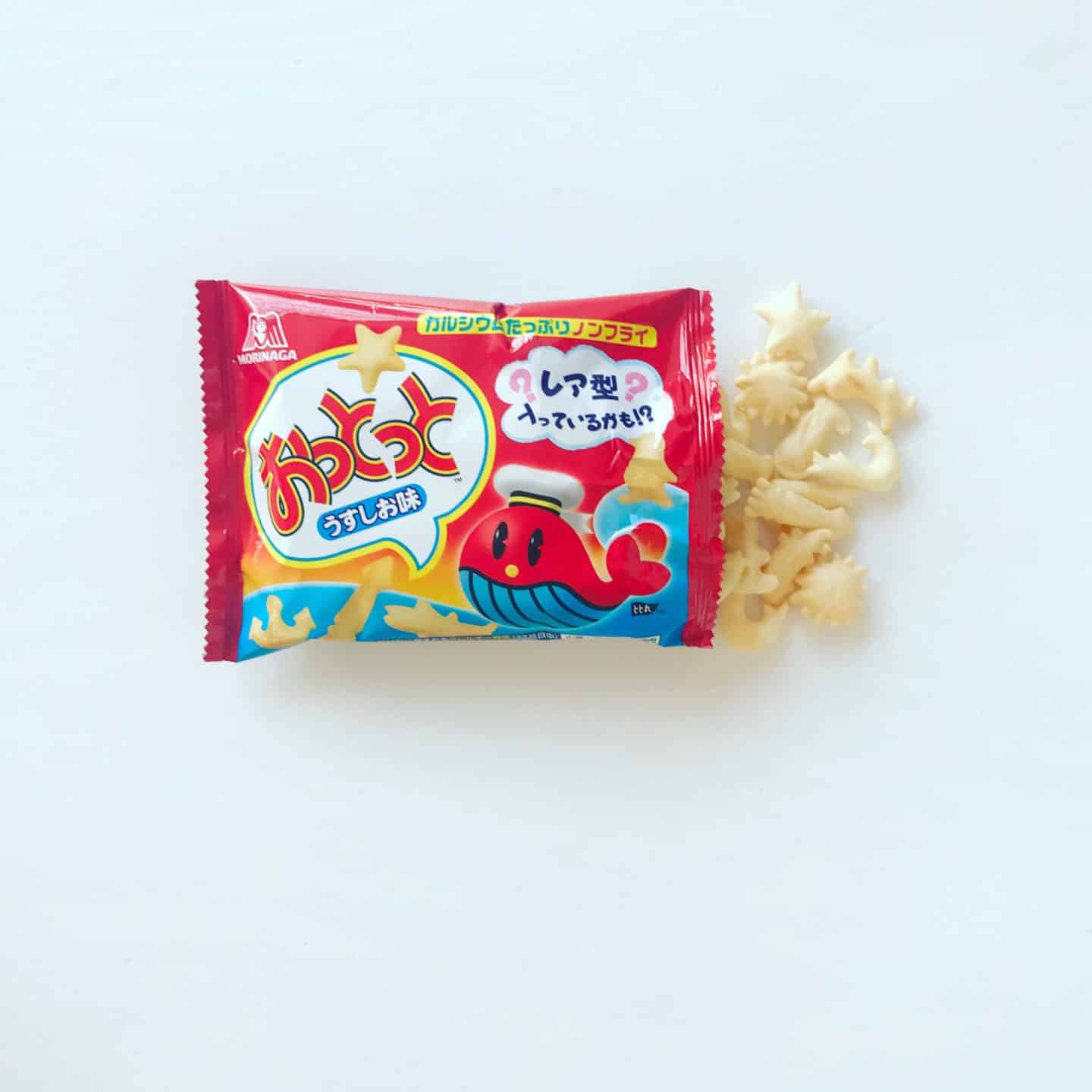
Here is some visual evidence of my child devouring these ( his favourite snack on the planet.)
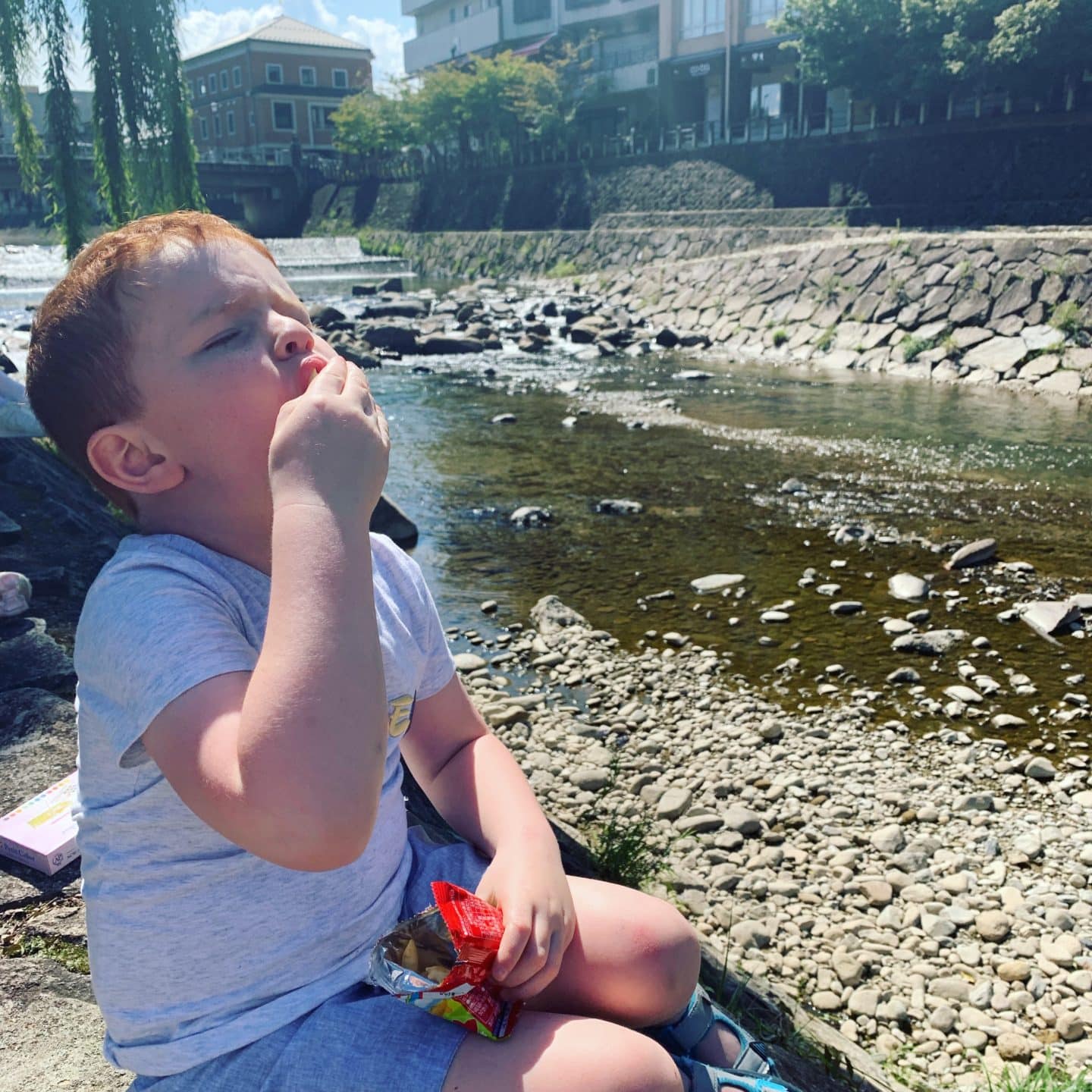
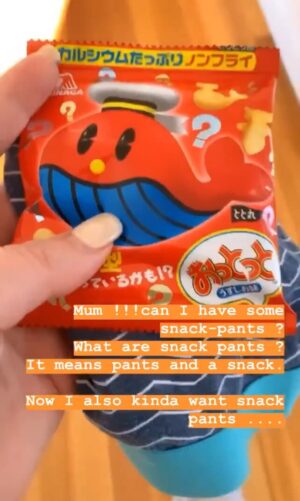
These are sold in some supermarkets, Don Quijote, some 100 yen shops and some drugstores.
I recommend downloading google translate and using it for reading ingredients and cooking instructions on the back of products.




